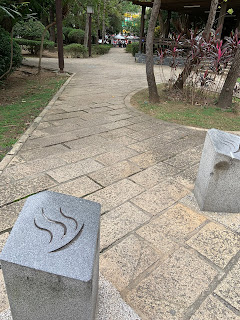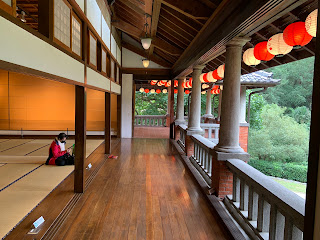台北メトロの新北投駅の隣に、日本時代の駅舎を復刻した施設があり、内部には鉄道に関する展示があります。以前新潟国際大学で公演を行った台湾人宮大工の方が、再建に携わったそうです。昔のガチャガチャなんかがありました。プラットフォームにはには客車があり、その内部で北投の温泉文化に関する展示があり「流し(台湾語でナカシ)」という温泉宿を回って客の歌の伴奏をする演歌バンドの紹介をする動画が放映されていました。流しのミュージシャンたちの間では、台湾人客にわからないように日本語の言葉を逆さ読みにする暗語があると言っていて、興味深かったです。カラオケ機器が普及してからは、廃れたそうです。そういえば、何年も前に義父の誕生日を北投の温泉旅館で祝った時、ナカシが呼ばれていて、何か歌わされたことがありました。温泉に入る時間がなかったので、入り口にある手湯で我慢しました。結構熱かったです。夜までお肌スベスベでした。手だけ。
Thinking out loud on issues of language teaching and learning in Taiwan, Japan and beyond
Sunday, November 28, 2021
クタガラン文化センターと温泉博物館
大正時代の街並みが残る斗六
先日、所要で西南部の雲林県斗六市に行った際、スキマ時間ができたので、日本軍杯を収集している台湾の方がやっている博物館に行こうと思ったのですが、休みでした。そこへ行く途中に、大正時代のバロック建築商店街が残っている地域を通過しました。台北の大稻埕や各地の老街のように観光地化はされておらず、大正時代と同じように普通の商店街です。ヘアサロンの二階には、日本語ローマ字で「CHOHATSU」なんて書いてあるのが残っていました。台湾では日本語の店名や看板は全く珍しくもありませんが、たまたま「清原」タピオカドリンク店、「あきら」ヘアサロン、「中村」ベーカリーと三軒ならんでいたのでパチリ。流石に南部の太陽はギラギラで、とても暑かったです。
Sunday, November 21, 2021
Prof. Higgins of Hokkien
Professor Higgins of Hokkien
A great sociolinguist and dialectologist of Taiwan
He started his Ph.D. when he was 50 years old!
He was able to tell the host's Hokkien was learned, not acquired 😆
I was inspired by Prof. Ang Uijin's work back in the late 90s when I was trying to learn Hokkien.
If Stephen Kranshen is right...
This was the first time I attended a Hokkien mass really "attentively" for the first time.
It was doubly tiring! But I think I did OK given that I had practiced the day before.
I understood about 60 to 70% of the homily. If Stephen Krashen is right, I will be super proficient in Hokkien soon (hopefully)!
After mass, I chatted with the priest.
He who had a Chiang-chiu accent during the mass, actually had a Choân-chiu accent when chatting informally! He is actually from Pak-tâu, which is a Tâng-oaⁿ accent area, a heavier accent than Siā-á for that matter! (Siā-á/Āu-káng Tâng-oaⁿ accent is closer to Taipei Standard accent, without centralized vowels.)
Perhaps owing to the fact that Hokkien mass is more prevalent in southern Taiwan, Chiang-chiu accent is uniformly used for masses: For example sèⁿ-miā, Goán, etc.
Anyway, I will go with the flow.
After that, I went along with some of the parishioners there to Shilin parish, where there was a pān-toh for Christ the King.
An Indonesian choir was performing. They were awesome!
The youth group performed a dance to the tune of "Kimetsu." It's popular even here 😮
U.S. “spy” plane over Au-káng-kîⁿ?
民國34年美軍拍的後港墘 (English follows below)
看得出277巷是「重要幹道」!
景祐宮不在現在的位置(你們當然知道)
後港當時是社子的一部份(講「同安腔」的,別於士林街的漳腔)
另外,酒店內和三角埔都在「後港生活圈」內
An aerial photo of Āu-káng-kîⁿ taken by US forces in 1945
You can see that Lane 277 was THE major thoroughfare!
And the temple in the corner wasn’t there. (Of course, you guys remember that!)
Au-káng was part of Siā-á back then (this explains your Tang-oaⁿ accent 😆) and the area of activity mainly extended north-south along the river.
Saturday, November 20, 2021
Connecting with the past in written language
Friday, November 19, 2021
Kanji lover's paradise
Wednesday, November 17, 2021
What LPP can teach us about BN30
I recently attended a conference here in Taipei where many discussions were over the Bilingual Nation 2030 (BN30) policy of Taiwan. Prior to attending the conference, I happened to have re-read books about Language Policy and Planning (LPP). This was helpful for coming up with some personal observations about the policy. Here are the three takeaways from the conference, informed by findings in LPP studies.
Number one: Two languages can never coexist stably in the same domain in the same society. Therefore, trying to teach content knowledge in two languages at the same time may end up to be a futile effort unless done very skillfully. The only way for multiple languages to coexist in one society is for those languages to be used in different domains. Within the context of elementary and secondary education in Taiwan, it seems that the main vehicle for conveying content knowledge will be Mandarin; while English will be used for classroom interactions.
Number two: It is very difficult to make people change their linguistic behavior, unless using very coercive means. Actually, Taiwan already is a very rare example of success. Under the high-handed one-party rule by the KMT, Mandarin successfully supplanted Hokkien (a.k.a Taiwanese), Japanese, and other indigenous languages in Taiwan because there was a large-scale stigmatization campaign of the latter by the government. As the democratization advanced, millions of dollars and massive effort went into revitalizing Hokkien, Hakka and aboriginal languages, but the attrition of those languages has been unstoppable. On the other hand, people tend to voluntarily shift towards the language with higher prestige that promises economic gain and ability to communicate with the larger society. This is why many Hakkas abandoned their language in favor of Hokkien, and later, Mandarin. What the KMT government succeeded in doing was artificially creating a situation where Mandarin became the prestige language. So, if English proves to be a language with real prestige and utility, people will jump at it without any coercion. (This may especially be the case, after hearing in the conference of a finding that very small percentage of Taiwanese people were worried that adopting English would threaten their cultural identity.)
Number three: Immersion approach may work best in changing the linguistic behavior of the next generation. In direct contradiction to the mainstream voice in the profession which claims using the learner's L1 to scaffold their L2 learning is the most efficient method, L2-only immersion programs are known to produce good results, where children acquired high proficiency in L2 while maintaining L1. However, it must be noted that many of these immersion success stories originate from locations where children get a lot of exposure to both languages outside classroom. It also presupposes that there is a sufficient number of teachers highly proficient in L2.
Based on the above points, here are some observations about the prospects of BN30. If the goal of the policy is to shift the medium of instruction (MoI) from Mandarin to English, the chance of success does not seem very high under the current approach. (Indeed, the policy statement of the Taiwanese government states that one of the main goals of the policy is to increase the number of students who are capable to attending English as a medium of instruction (EMI) courses in universities.) It may succeed, though, in replacing Mandarin with English as the language of classroom interaction between teachers and students, while the medium for imparting content knowledge remains Mandarin. This will create a situation hitherto non-existent in Taiwan, namely, English being used as a language for domestic communication, albeit in limited domains. It may have an indirect effect of creating a generation more predisposed to learning English further, so as to enter EMI programs in higher education. In any case, it is essential for the government to clarify the goals of BN30 in more concrete terms, and adopt measures that are more finely tuned to accomplish them.
Sunday, November 7, 2021
Parishes in Yunlin with prominent vocations
Chúi-bé (水尾) parish is in Lunbei, Yunlin County. The entire village is surnamed Chung and catholic. So this small parish is like their family church. Even the current archbishop of Taipei is from this parish!
It was founded by a local couple who were lay catechists. Lay catechists are important!
In nearby village of Chhiú-á-kha (樹仔腳;饒平), there is also a prominent parish that produced a lot of vocations.
In the churchyard, there's a big open space for pān-toh. It must seldom rain here!
Thank you, Fr Chang Chin-chen, for your warm hospitality!
Monday, November 1, 2021
琉球ウミンチュの像
Ruins of Todos Los Santos in San Salvador (Keelung)
The post city of Keelung used to be called San Salvador when it was under Spanish occupation. Several years ago, archeologists found the ruins of the Dominican Church of All Saints (Todos los Santos) under a parking lot. They also found human remains and some items including a cross. It was here that Japanese Dominican missionaries from Manila were formed before being sent to Japan only to be martyred there. All the saints, particularly the Dominican missionaries who worked evangelization of Japan, pray for us!
By the way, had the Spaniards not been kicked out by the Dutch, Taiwan would have been part of the Philippines today. The local Basay language belongs to the Malayo-Polynesian (Austronesian) language family and shares many similarities with Philippine languages. For example, "ulan" means rain in both Basay and Tagalog! Besides, the Spaniards brought in many Kapampangans from central Luzon to fight against the invading Dutch. And even today, there are many guest workers from the Philippines all over Taiwan, including Keelung.











































